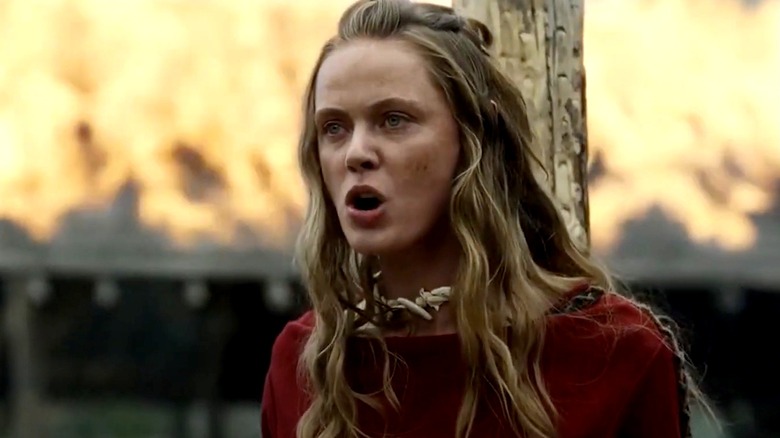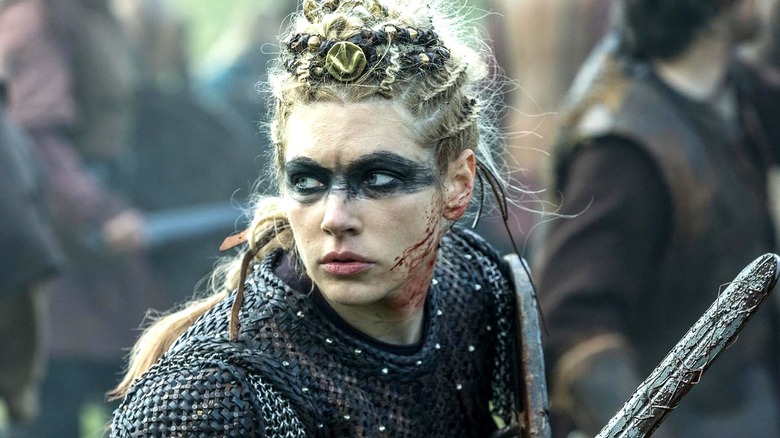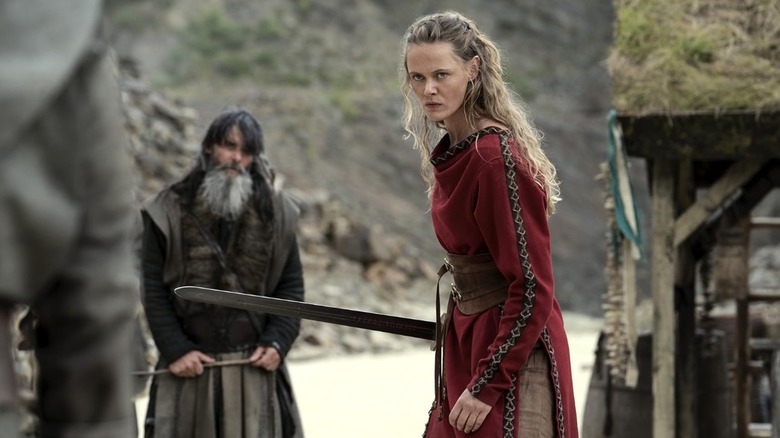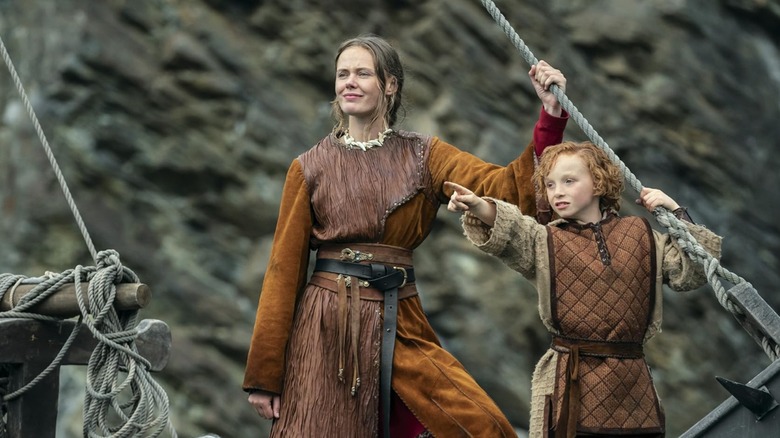Vikings: Valhalla's Confusing Timeline Problems & How They Ruined Everything
With its medieval world of ancient Nordic gods, fierce shield-maidens, axe-wielding warriors clad in snug leather, and a mostly untamed North Sea, the History Channel's "Vikings" presents a bewitching account of legendary figure Ragnar Lothbrok (Travis Fimmel). The series, which imagines Ragnar's journey from simple farmer to the Scandinavian king responsible for Vikings raiding and ultimately colonizing communities throughout Europe and beyond, wove together six seasons' worth of tales from medieval Scandinavian sagas.
The Netflix sequel "Vikings: Valhalla" picks up the Viking saga long after Ragnar's death. And much like the tricky "Vikings" timeline, the timeline of the later series, which recounts the exploits of the last great legendary heroes of the Viking Age, condenses historical events in a way that can be hard to follow at times.
Like "Vikings," many of the plotlines in "Valhalla" are connected to real historical events. The three-season series, which primarily follows famed Viking siblings Leif Erikson (Sam Corlett) and Freydís Eiríksdóttir (Frida Gustavsson), begins about a century after Ragnar's death with the St. Brice's Day Massacre of 1002 C.E. But while the end of the series depicts Harald's (Luke Harmon) ascension to solo Viking king after the death of his co-ruler and nephew Magnus (Set Sjöstrand), which historically occurred in 1047 C.E., the ages and experiences of the characters don't exactly line up with their real-world counterparts. In other words, it's best not to look too closely at the timeline.
The Valhalla story follows Ragnar's exploits
To understand where "Valhalla" fits in, it's important to revisit "Vikings." When the series begins, seasonal raids are already fundamental to the Viking way of life. Against his earl's wishes, Ragnar leads a westward raid aboard a new longship, a gambit that leads to many lucrative sacks of England. Ragnar's raids quickly aid his rise to power, first to earl and ultimately to king of Kattegat. Completing the Seer's prophecy that Ragnar would have many sons, he has five sons between his first wife Lagertha (Katheryn Winnick) and second wife, Aslaug (Alyssa Sutherland).
Impressed by the land in Wessex, Ragnar begins efforts to establish a colony there on land granted by King Ecbert before leading Vikings from Scandinavia to the Siege of Paris, which they successfully raid on their third attempt using Ragnar's "death" as a Trojan horse. Afterward, Ragnar's brother Rollo (Clive Standen) turns against him in exchange for a title and a princess bride from Emperor Charles (Lothaire Bluteau) — an event that leads to the establishment of the Norman settlement.
Years later, Ragnar's execution in England via a snake pit leaves his sons desperate for vengeance. Together, they lead the Great Heathen Army — a massive coalition of Vikings from across Scandinavia — to defeat the four English kingdoms, resulting in the establishment of Danelaw. By the end of the series, Ragnar's son Bjorn (Alexander Ludwig) becomes king of Kattegat while his son Ubbe (Jordan Patrick Smith) explores Iceland and North America.
The timeline of Vikings: Valhalla
In real life and both of the "Vikings" series, part of the key to the Vikings' success was their ability to integrate into other cultures and communities. After the initial shock of the violent raiding and sacking, Norsemen were fairly skilled at adapting to other cultures within a generation or two. But this came with a price: the loss of the old Viking ways. While Ragnar's raids were inspired by his belief in the old gods and Odin, those ways are dying out by the time of "Vikings: Valhalla" a mere century later — especially after King Æthelred II (Bosco Hogan) wipes out a long-established community of Viking settlers.
As Vikings gather at Kattegat to plan their response, siblings Leif Erikson and Freydís Eiríksdóttir travel from Greenland to take revenge on the Christian Jarl Olaf Haraldsson for his violent assault on Freydis. From there, Leif sails to England with Harald Sigurdsson while Freydis becomes the leader of the last safe place for pagan pilgrims, Jomsborg. Leif and Harald travel to Constantinople and Sicily, where they lead their Varangians (Scandinavian Russians) alongside the Byzantine army against the Saracen fortress. Forced from Jomsborg while fleeing Christian attacks, Freydis eventually reunites with her brothers, and, together with the other pagan refugees, they set out for Greenland at the end of the series.
The history behind Vikings: Valhalla
Like the legendary sagas the series is based on, "Vikings" doesn't always line up precisely with the real history behind it. In the same spirit, "Valhalla" takes a lot of liberties with historical dates. While the series offers a good introduction to many of the famous names connected to Viking history and the legendary Scandinavian sagas, any effort to make the timeline make sense will only lead to confusion. Much like King Arthur of Arthurian legend, whether Ragnar Lothbrok was a real human being or an inspiring myth is up for debate, even if his story seems to coincide with real events like the 885 Seige of Paris.
While the historicity of Leif Erikson's existence is considered likely, the story of his and Freydis' adventures comes from the two medieval Vinland sagas: the Saga of the Greenlanders and the Saga of Erik the Red. The prospect is supported by Newfoundland's L'Anse aux Meadows National Historic Site, where a 1000-year-old Viking settlement was first discovered in the 1960s. Since much of "Valhalla" focuses on Freydis' commitment to keeping the old faith alive, it makes narrative sense to connect her story to the St. Brice's Day massacre of 1002. Freydis and Leif arrive in Kattegat as the Vikings gather to plan their revenge, and she becomes pregnant shortly thereafter.
According to the sagas, Jomsborg's destruction took place in 1043 — more than 40 years later. But Freydis' son Harald is still young, and it's clear 40 years have not taken place since the beginning of the series. To further confuse things, the Varangian guard historically fought with the Byzantine army in 1034 instead of around the same time as Jomsborg's fall. While it could be that the Vikings took a very long time to plot their revenge or Freydis and Leif age very well, her son Harald's age throws a wrench in the timeline, further ruining the series' historical authenticity.



